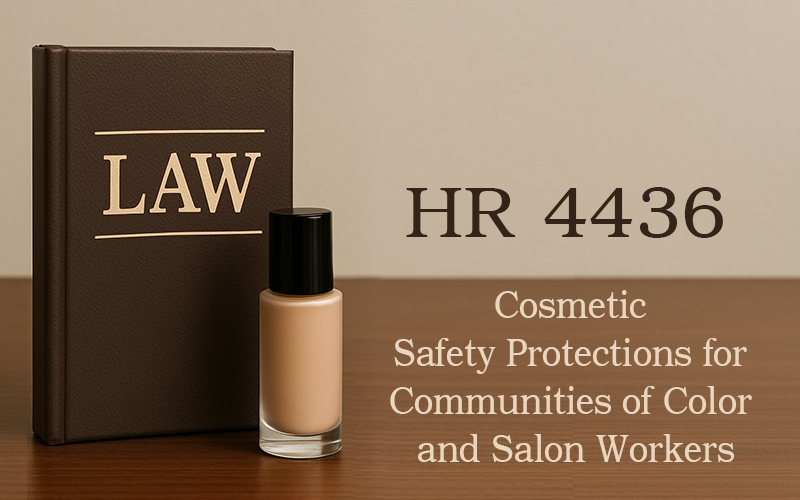The fourth and final bill included in the Safer Beauty Bill Package is H.R. 4436 – Cosmetic Safety Protections for Communities of Color and Salon Workers Act, introduced by Reps. Schakowsky and Pressley. It funds research, resource materials, education and outreach, and the development of safer chemicals to protect the health of women of color and salon workers. This bill also requires the FDA to regulate the safety of synthetic braids, which can contain toxic chemicals.
If passed, this bill will not have any immediate impact most on soap and cosmetic makers. Manufacturers of cosmetic products intended for professional use and salon owners and employees will have additional requirements regarding safety data sheets (see below).
The likelihood of this bill passing is very small.
Research
Much of HR 4436 is devoted to mandating and funding research into various areas. This is not my area of expertise, but I will summarize as best I can.
Health Disparities Related to Cosmetics Impacting Communities of Color
The bill mandates that Public Health Services conduct, or award grants for, epidemiological, clinical, ecological, and social scientific investigations into chemicals that are in cosmetic products used by women and girls of color (beauty, personal hygiene, and intimate care products, especially). The research should look into what harmful chemicals are found in those cosmetics, specific health effects, and interventions that could reduce exposure or harm. Then, not more than 5 years after awarding the first grant, the data should be made publicly available and a report submitted to the House Committee on Energy and Commerce and the Senate Committee on Health, Education, Labor, and Pensions. The bill appropriates $7.5 million for 5 years after the bill passes.
Health Concerns Impacting Professional Nail, Hair, and Beauty Salon Workers
Similar research is also mandated to be conducted regarding chemicals that are linked to adverse health effects and are most commonly found in cosmetics used by professional nail, hair, and beauty salon workers. The data must be published and reports made to the House and Senate within 5 years of the first grant being awarded. An appropriation of $7.5 million is made to cover the costs.
Support for Safer Alternatives
Additional research or grants are mandated to support research focused on the design of cosmetic chemicals that have no inherent toxicity or association with adverse health effects. Focus should be on replacing chemicals in professional products used by salon workers, replacing chemicals in cosmetic products marketed to women and girls of color, and providing assistance to minority-owned cosmetic companies in creating safer cosmetic products for women or girls of color or professional nail, hair, and beauty salon workers. The bill includes an appropriation of $10 million for this portion of the research.
National Resource Centers
The bill mandates the creation of a National Resource Centers on Beauty Justice and National Resource Centers on Salon Worker Health and Safety.
For each National Resource Center, an appropriation of $2 million is made for a grant to establish the center, to address unsafe cosmetic chemical exposure experienced by consumers or salon works who are:
- women and girls of color;
- men and boys of color;
- immigrant populations;
- language minorities;
- the LGBTQIA community; and
- other underserved populations as determined appropriate by the Secretary of Health and Human Services for purposes of this subsection.
There are specifics on the requirements for the grants and what the funds of the grant must be used for.
Safety Data Sheets
Within 18 months of the enactment of the bill, the Secretary of Labor must issue a standard under the Occupational Safety and Health Act (OSHA) that requires :
- Each manufacturer or importer selling a cosmetic for professional use must obtain or develop a Safety Data Sheet (SDS) for each cosmetic made or imported which includes a hazardous chemical. They must make the SDS available on their website (in addition to any other required manner) in English, Spanish, Vietnamese, Chinese, Korean, and upon request, other languages.
- Each distributor of a cosmetic for professional use must provide SDS sheets with the products they distribute.
- Each employer or operator of a salon must provide SDS for the cosmetics that are used in the course of providing services.
Synthetic Hair Braids
HR 4436 would amend the definition of a cosmetic to included synthetic braids, so it would then read:
Articles intended to be rubbed, poured, sprinkled, or sprayed on, introduced into, or otherwise applied to the human body or any part thereof for cleansing, beautifying, promoting attractiveness, or altering the appearance (including synthetic braids),
The FDA would have 1 year to issue regulations establishing the safety standards for the use of synthetic braids.
Synthetic braids must meet the standards, or must have a warning label on the product label and on their website that states “This productg does not meet the FDA’s standard of safety for synthetic braids.”


Leave a Reply